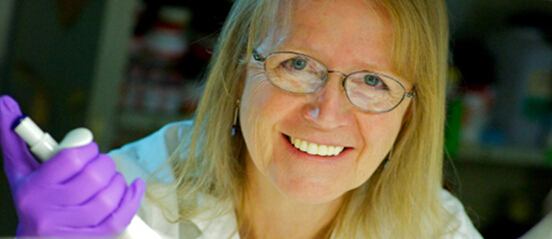加州大学河滨分校
University of California Riverside
Ameae M. Walker, Ph.D. Introduction in Chinese

一、现任行政及学术职务 加州大学河滨分校澳门bet356体育在线官网教授,加州大学河滨分校副董事长,加州大学河滨分校学术委员会副主席,加州大学澳门bet356体育在线官网教授委员会主席。
二、教育经历:
1979 美国耶鲁大学澳门bet356体育在线官网博士后。
1976 英国利物浦大学博士研究生。
1973 英国利物浦大学本科。
三、研究领域:
1、乳腺癌:(1)乳腺癌的分子机理;(2)催乳素及催乳素受体在乳腺癌形成、发展及预后中的作用;(3)乳腺癌的治疗(药物设计)。
2、免疫学:乳汁中免疫细胞对后代胸腺发育之影响。
Introduction in English
CONTACT INFORMATION
UniversityofCalifornia, Riverside
Riverside,CA92521
Tel: (951) 827-5942
Fax: (951) 827-5504
E-mail: ameae.walker@ucr.edu
Office: 1255 Webber Hall
EDUCATION AND TRAINING
Postdoctoral Cellbiology,YaleUniversityMedicalSchool, 1979
Ph.D. Cellbiology,UniversityofLiverpool, 1976
BSc (Honors)Biochemistry,UniversityofLiverpool, 1973
VISIT AMEAEWALKER'S LIVING THE PROMISE PAGE
·
RESEARCHSUMMARY
Wehave two major areas of interest in my lab: the growth-factor andcancer-promoting activities of the hormone prolactin, and the role milk immunecells play in development of the thymus in offspring.
Prolactin: Prolactin has growth factor (as well as other) activities in manytissues, including the pituitary, breast, smooth muscle-like cells, prostate,ovary, and cells of the immune system. Although most prolactin is produced bythe pituitary, some is produced in these other tissues where it can act as anautocrine or paracrine growth factor. In all of these tissues, we havedemonstrated antagonism between unmodified and phosphorylated prolactin (or amolecular mimic thereof) in the regulation of growth; this antagonism can bedisturbed, leading to increased cell proliferation or decreased apoptosis orboth. This antagonism is most dramatically demonstrated in vivo where we have,for example, shown the molecular mimic of phosphorylated prolactin tocompletely inhibit pregnancy- associated growth of the mammary gland, and theformation of tumors from human prostate cancer cells. The mimic ofphosphorylated prolactin works in large part by altering splicing of prolactinreceptors to produce a form that both acts as a dominant negative to the growthsignal-transducing form, as well as itself transducing a signal leading to cellcycle arrest and apoptosis. As part of our analyses, we therefore investigatethe posttranslational modification of prolactin, the regulation of prolactinrelease, prolactin-receptor interactions, signal transduction, and effects ongene transcription in each of these tissues. The laboratory uses a wide spectrumof techniques ranging from microscopy to molecular biology to analysis innormal and transgenic animal models.
Milkimmune cells: The benefits of nursing are manifoldand, beyond the delivery of nutrients, include the transfer of antibodies and theresultant passive immunization of babies. In addition, we have demonstrated thespecific transcytosis of T lymphocytes in the milk across the gastrointestinalepithelium of offspring and their subsequent homing to the thymus. Thesetransferred cells affect development of the offspring’s own thymocytes andimmune responses when the offspring are adult. The long-term objectives of thisproject are to determine the importance of maternal milk cell transfer toimmune responses in offspring, especially as such transfer might relate a) to Tcell development in general, b) to sexual dimorphism both in susceptibility toimmune disease and the efficacy of immunization, and c) to the possibility ofsafely enhancing immunity in young children.
AWARDS
· Award for teaching excellencefrom the MD classes of 1994, 2007, 2010, 2011.
· Fellow, Royal Society ofMedicine, 2008.
· Elected to the Academy ofDistinguished Teachers, 2006.
· Keynote Speaker at JapanesePituitary Society Meeting, 2001.
· Cancer Federation ResearchRecognition Award, 1997.
· Recipient of CampusDistinguished Teaching Award, 1994.
· Faculty Research Lecturer,Kitasato University,Japan, 1993.
· Travel award from the WelcomeTrust, 1976.
· Medical Research Council (England)Predoctoral Fellowship, 1973-1976.
SELECTED PUBLICATION Yang
· YangNY, Lopez-Bergami P, Goydos JS, Yip D,WalkerAM, Pasquale EB,Ethell IM. The EphB4 receptor promotes the growth of melanoma cells expressingthe ephrin-B2 ligand. Pigment Cell Melanoma Res. 2010 Oct;23(5):684-7.
· Terasaki Y, Yahiro K,Pacheco-Rodriguez G, Steagall WK, Stylianou MP, Evans JF, Walker AM, Moss J.Effects of prolactin on TSC2-null Eker rat cells and in pulmonarylymphangioleiomyomatosis. Am J Respir Crit Care Med. 2010 Aug 15;182(4):531-9.
· Tan D, Walker AM. Short form1b human prolactin receptor down-regulates expression of the long form. J MolEndocrinol. 2010 Mar;44(3):187-94.
· Huang KT, Walker AM. Long termincreased expression of the short form 1b prolactin receptor in PC-3 humanprostate cancer cells decreases cell growth and migration, and causes multiplechanges in gene expression consistent with reduced invasive capacity. Prostate.2010 Jan 1;70(1):37-47.
· Ueda EK, Soares CR, BartoliniP, DeGuzman A, Lorenson MY,WalkerAM. A molecular mimic of phosphorylated prolactin (S179D PRL) secreted byeukaryotic cells has a conformation with an increased positive surface chargecompared to that of unmodified prolactin. Biochemistry. 2009 Jul28;48(29):6887-97. Erratum in: Biochemistry. 2009 Sep 15;48(36):8764.
· Chen Y, Huang K, Chen KE,WalkerAM. Prolactin andestradiol utilize distinct mechanisms to increase serine-118 phosphorylationand decrease levels of estrogen receptor alpha in T47D breast cancer cells.Breast Cancer Res Treat. 2010 Apr;120(2):369-77.
· HelenaCV, McKee DT, Bertram R,WalkerAM, Freeman ME. The rhythmic secretion of mating-induced prolactin secretion iscontrolled by prolactin acting centrally. Endocrinology. 2009Jul;150(7):3245-51.
· Deng C, Ueda E, Chen KE, BulaC,NormanAW,Luben RA, Walker AM. Prolactin blocks nuclear translocation of VDR byregulating its interaction with BRCA1 inosteosarcoma cells. Mol Endocrinol. 2009 Feb;23(2):226-36.
· Ma LJ, Walter B, Deguzman A,Muller HK, Walker AM. Trans-epithelial immune cell transfer during sucklingmodulates delayed-type hypersensitivity in recipients as a function of gender.PLoS One. 2008;3(10):e3562.
· Huang K, Ueda E, Chen Y,Walker AM. Paradigm-shifters: phosphorylated prolactin and short prolactinreceptors. J Mammary Gland Biol Neoplasia. 2008. Mar;13(1):69-79.
· Tan D, Huang KT, Ueda E,WalkerAM. S2 deletionvariants of human PRL receptors demonstrate that extracellular domainconformation can alter conformation of the intracellular signaling domain.Biochemistry. 2008 Jan 8;47(1):479-89. Epub 2007 Dec 15.
· Guzmán EA, Langowski JL, DeGuzman A, Muller HK, Walker AM, Owen LB. S179D prolactin diminishes the effectsof UV light on epidermal gamma delta T cells. Mol Cell Endocrinol. 2008 Jan2;280(1-2):6-12.
· Williams VL, DeGuzman A, DangH, Kawaminami M, Ho TW, Carter DG, Walker AM. Common and specific effects ofthe two major forms of prolactin in the rat testis. Am J Physiol EndocrinolMetab. 2007 Dec;293(6):E1795-803.
· Wang Y, Chiu CT, Nakamura T,Walker AM, Petridou B, Trousdale MD, Hamm-Alvarez SF, Mircheff AK, SchechterJE. Traffic of endogenous, transduced, and endocytosed prolactin in rabbitlacrimal acinar cells. Exp Eye Res. 2007 Dec;85(6):749-61.
· Wu W, Zanello L,WalkerAM. S179Dprolactin sensitizes human prostate cancer cells such that physiological concentrationsof 1, 25 dihydroxy vitamin D3 result in growth inhibition and cell death.Prostate. 2007 Oct 1;67(14):1498-506.
· WalkerAM. S179D prolactin:antagonistic agony! Mol Cell Endocrinol. 2007 Sep 30;276(1-2):1-9.
· Ma LJ, Guzmán EA, DeGuzman A,Muller HK,WalkerAM, Owen LB. Local cytokine levels associated with delayed-typehypersensitivity responses: modulation by gender, ovariectomy, and estrogenreplacement. J Endocrinol. 2007. May;193(2):291-7.
· Wang Y, Chiu CT, Nakamura T,Walker AM, Petridou B, Trousdale MD, Hamm-Alvarez SF, Schechter JE, MircheffAK. Elevated prolactin redirects secretory vesicle traffic in rabbit lacrimalacinar cells. Am J Physiol Endocrinol Metab. 2007 Apr;292(4):E1122-34.
· WalkerAM. Therapeuticpotential of S179D prolactin--from prostate cancer to angioproliferativedisorders: the first selective prolactin receptor modulator. Expert OpinInvestig Drugs. 2006 Oct;15(10):1257-67.
· Wu W, Chen YH, Ueda E, Tan D,Bartolini P, Walker AM. Different forms of prolactin have opposing effects onthe expression of cell cycle regulatory proteins in differentiated mammaryepithelial cells. Oncol Res. 2006;16(2):75-84.
invisible






